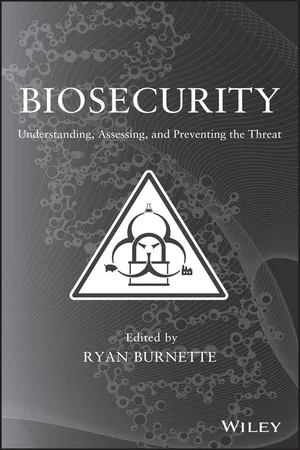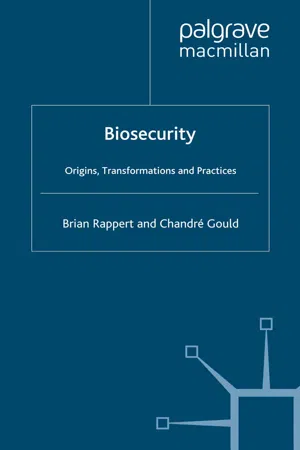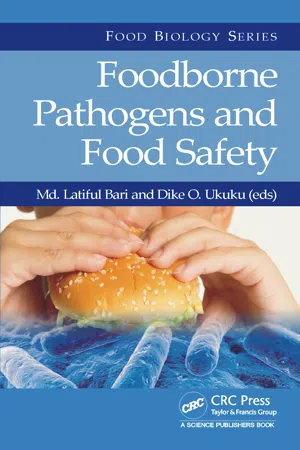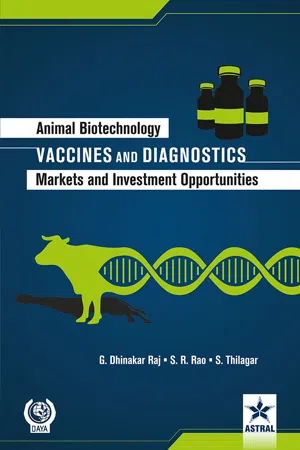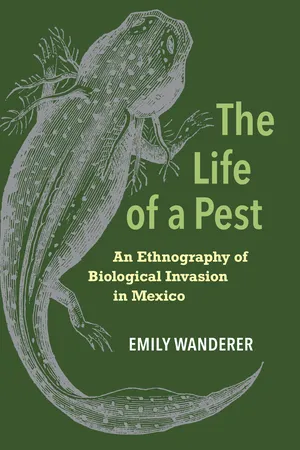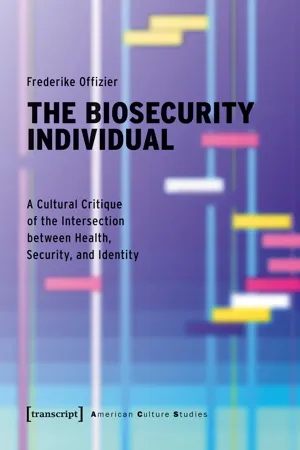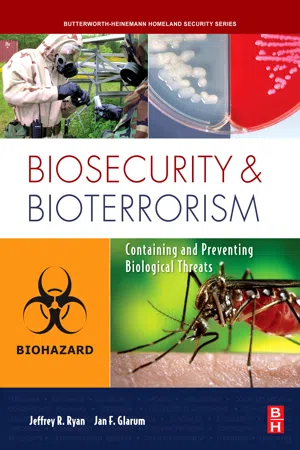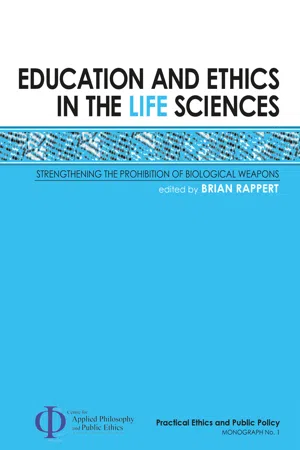Biological Sciences
Biosecurity
Biosecurity refers to measures designed to protect against the entry and spread of harmful organisms, such as viruses, bacteria, and pests, in a specific area. This can include protocols for controlling the movement of people, animals, and goods, as well as procedures for managing and containing potential biohazards. The goal of biosecurity is to safeguard the health and safety of living organisms and the environment.
Written by Perlego with AI-assistance
Related key terms
1 of 5
11 Key excerpts on "Biosecurity"
- eBook - ePub
Biosecurity
Understanding, Assessing, and Preventing the Threat
- Ryan Burnette(Author)
- 2013(Publication Date)
- Wiley(Publisher)
PART I
AN INTRODUCTION TO Biosecurity
Passage contains an image
CHAPTER 1
Defining Biosecurity and Related Concepts
Ryan N. Burnette, Jenna E. Hess, Joseph P. Kozlovac, and Jonathan Y. RichmondWHAT IS Biosecurity?
Biological security, or “Biosecurity,” is not easy to define and elicits a variety of interpretations. Thus, it is important to clearly define the context in which the term is used. In a broad sense, it is a “strategic and integrated approach, encompass[ing] the policy and regulatory frameworks that analyze and manage risks in the sectors of food safety, animal life and health, and plant life and health, including associated environmental risk.”1 However, Biosecurity is not limited to policy and regulation, as this book demonstrates. For the purpose of defining Biosecurity, this chapter focuses on elements of laboratory Biosecurity.Laboratory Biosecurity is a [set of] concepts and practices used to secure sensitive biological materials from persons or entities that should not have access.2 The World Health Organization (WHO) refers to “laboratory Biosecurity … [as the] institutional and personal security measures designed to prevent the loss, theft, misuse, diversion, or intentional release of pathogens and toxins.”3 Biosecurity is not strictly limited to biological agents or harmful byproducts. It also applies to products having intrinsic value, such as novel vaccines, biological therapeutics, information-technology platforms, synthetic nanoparticles or organisms, and products having high monetary value or related to biological agents. These will be referenced throughout this book as valuable biological material, or VBM.Biosecurity as a field likely originated from its applications in controlling the release of genetically modified organisms, or GMOs, into indigenous environmental populations.4 As with other condensed “bio” terms, the inclusion of the word “Biosecurity” into popular vernacular was firmly established following the attacks of September 11, 2001. The Centers for Disease Control and Prevention (CDC) and the National Institute of Health (NIH) recognize that a robust biosafety program includes many facets of Biosecurity and that it assumes many definitions.5 - eBook - PDF
Biological Safety
Principles and Practices
- Dawn P. Wooley, Karen B. Byers, Dawn P. Wooley, Karen B. Byers(Authors)
- 2020(Publication Date)
- ASM Press(Publisher)
Mee et al. defned Biosecurity as hav- ing two components. Bioexclusion relates to preventive measures (risk reduction strategies) designed to avoid the introduction of pathogenic infections (hazards), whereas biocontainment relates to measures to limit within-farm transmission of infectious hazards and onward spread to other farms (14). The Food and Agriculture Organization of the United Nations defnes Biosecurity in a much broader way as “a strategic and integrated approach that encompasses the policy and regulatory frameworks (including instruments and activities) that analyze and manage risks in the sec- tors of food safety, animal life and health, and plant life and health, including associated environmental risk. Bi- osecurity covers the introduction of plant pests, animal pests and diseases, and zoonoses, the introduction and re- lease of genetically modifed organisms (GMOs) and their products, and the introduction and management of inva- sive alien species and genotypes. Biosecurity is a holistic concept of direct relevance to the sustainability of agri- culture, food safety, and the protection of the environment, including biodiversity” (15). In the research laboratory or vivarium settings where highly infectious animal pathogens are being used, bio- security is often used and defned as “the protection of microbial agents from loss, theft, diversion or intentional 652 | SPECIAL ENVIRONMENTS misuse.” This defnition is consistent with the American Biological Safety Association (ABSA) usage of this term, the current World Health Organization (WHO) (16) usage, and the U.S. government’s usage (3) and is also very relevant to the agricultural research and diagnostic setting as well. FIELD BIOSAFETY Working with large animals in a feld setting is a common and necessary task for those who handle livestock. Large agricultural animals are often kept in open pens or on the open range because of their size and difculties housing them. - eBook - PDF
Biosecurity
Origins, Transformations and Practices
- Brian Rappert, Chandré Gould(Authors)
- 2009(Publication Date)
- Palgrave Macmillan(Publisher)
Suwit Wibulpolprasert spoke to wide ranging negative economic and social repercussions of recent attempts to prevent the spread of avian flu within duck and bird populations in southeast Asia. More recently though, Biosecurity has taken on additional dimen- sions aligned with national security agendas. Those security dimen- sions associated with the deliberate spread of disease provide the shared concern for the chapters in this volume. While attention to the inadvertent and so-called natural spread of disease also informs the chapters, Biosecurity is addressed principally through attention to its intentional spread. In this sense, the bulk of this volume is in line with an Organisation for Economic Cooperation and Development (OECD) definition of Biosecurity as measures to ‘protect against the malicious use of pathogens, parts of them, or their toxins in direct or indirect acts against humans, livestock or crops’. 6 Biosecurity: In the lab Much of the concern about malicious use has related to the diversions of laboratory materials from legitimate facilities. The 2006 World Health Organisation (WHO) report Laboratory Biosecurity Guidance worked with this meaning. Biosecurity was said to pertain to ‘reducing the risk of unauthorized access, loss, theft, misuse, diversion or intentional release of [valuable biological materials] to tolerable, acceptable levels’ (WHO 2006: 11). The range of measures noted for enhancing bio- security included: limiting access to certain materials, keeping records (for instance, about inventories), enacting approval procedures for those Brian Rappert 7 working with materials, undertaking biorisk assessments, disposing of materials, reporting security breaches, and fostering a positive culture of responsibility. Salerno and Gaudioso’s (2007) Laboratory Biosecurity Handbook offers a detailed risk assessment guide for lab workers and managers. - eBook - PDF
- Md. Latiful Bari, Dike O. Ukuku(Authors)
- 2015(Publication Date)
- CRC Press(Publisher)
2 Owner, Biosafety Biosecurity International, 1165 Reston Avenue Herndon, VA 20170, USA. * Corresponding author: [email protected] 290 Foodborne Pathogens and Food Safety standardized processes for enhancing biosafety and Biosecurity have been developed. In many countries Biosecurity is inextricably linked to biosafety; where biosafety encompasses biocontainment to prevent accidental release and safeguard workers’ health, Biosecurity aims toward the prevention of possible malicious theft, misuse and release of organisms (WHO, 2006). This de fi nition of biosafety and Biosecurity is consistent with current World Health Organization (WHO) and American Biological Safety Association (ABSA) usage of these terms. In some countries the concept of biosafety and Biosecurity are described using a single word such as bioversicherung in German; bioseguridad in Spanish and in Russia the transliteration for security is used to describe both concepts. Biosecurity has been practiced in the laboratory setting for many decades and is not a new concept. Addressing biosafety and Biosecurity together has been newly coined as biorisk management. Developing a comprehensive biosafety risk assessment or biorisk management matrix to measure a weighted value of each risk has become the norm. The use of proper safety and security procedures and equipment, appropriate facility design and construction, and of paramount importance, the proper training of employees ensures not only their own safety but that of the community and environment (Nordman, 2010). Countries are increasingly developing Biosecurity regulatory requirements based on the risk group of pathogens and toxins, creating ‘schedules’ that list speci fi c pathogens and toxins that should be subject to varying degrees of control and protection. - Raj, G Dhinakar(Authors)
- 2018(Publication Date)
- Daya Publishing House(Publisher)
9: Biosafety 9.1 Introduction Biosafety As per the defnition of World Health Organization (WHO), biosafety includes the containment principles, technologies and practices that are implemented to prevent unintentional exposure to pathogens and toxins, or their accidental release. Therefore, biosafety is preventing the harmful organisms from escaping from the laboratory and protecting the handlers and environment from the organisms. Biosecurity Biosecurity means ‘protecting the pathogens from misuse, theft or intentional release’ by means of proper institutional and personal security measures and procedures. In spite of the known hazards of pathogenic micro-organisms, laboratory handling of the pathogens is often necessary: To identify the disease causing agent To develop prevention and therapeutic measures against the infectious disease To get insight into the properties of the organisms However, personnel and environmental safety should be given the highest importance while using the pathogenic organisms for the above said reasons. Containment facilities and biocontainment-practices are therefore developed to protect laboratory personnel, adjacent communities, animal agriculture and the environment from being exposed to potentially hazardous biological agents. The choice of appropriate containment facility with the requisite infrastructure and biosafety practices depends on the risk perception levels. This ebook is exclusively for this university only. Cannot be resold/distributed. 9.2 Risk Perception and Biosafety Level Category of thePathogens Infectious agents are categorized based on their relative risk perception and the following factors are considered in making this classification.- eBook - PDF
Power and Responsibility
Building International Order in an Era of Transnational Threats
- Bruce D. Jones, Carlos Pascual, Stephen John Stedman(Authors)
- 2009(Publication Date)
- Brookings Institution Press(Publisher)
BIOSAFETY (WORKING WITH PATHOGENS). The World Health Organi-zation defines biosafety as practices implemented to prevent uninten-tional exposure to pathogens or their accidental release. In many cases facilities and research centers are aware of the need for such measures but they are not necessarily obligated to abide by regulations. For exam-ple, government-funded organizations in the United States must follow the biosafety guidelines of the Centers for Disease Control and the National Institutes of Health, but adherence is optional for other institu-158 SECURITY IN THE BIOLOGICAL CENTURY tions. National biosafety regulations could be effective, but allowing governments to set their own standards in this area would not necessar-ily lead to an overall strengthening of the regime. Biosecurity (PRECLUDING UNAUTHORIZED ACCESS TO AGENTS, TECHNOLOGY, AND KNOWLEDGE). While signatories to the BWC are pro-hibited from making biological weapons, individuals generally are not restricted from possessing biothreat agents. Not all countries have enacted legislation criminalizing the development, production, and use of biological weapons by individuals. The 1996 BWC Review Conference “strongly urged” states to pass criminal legislation barring offensive bio-logical weapons research. Yet, as of 2001, only twenty-seven of forty-five states that provided any information to the United Nations said that they had done anything in that regard, while ninety-eight states failed to sub-mit any data whatsoever. Again, if left to individual countries, the out-come may not be acceptable. At the industry and university level, laboratories may be familiar with biosafety issues, but they are generally unaccustomed to the concept of Biosecurity—for example, the need for enhanced on-site security meas-ures, access and transfer regulations for pathogens, or even monitoring of the stocks of pathogens or toxins that they possess. - Katti, Gururaj(Authors)
- 2018(Publication Date)
- Daya Publishing House(Publisher)
Biosecurity covers the aspects of security related to introduction of plant pests, animal pests and diseases, and zoonoses, and also the introduction and release of genetically modified organisms (GMOs) and their products. Thus, it is a holistic concept that covers safe This ebook is exclusively for this university only. Cannot be resold/distributed. transboundary movement of commodities, the potential threat of pests and diseases in biowarfare and also the indigenous threat of emerging pests due to changing climate and cropping pattern, and biosafety issues related to use of transgenics. This paper primarily confines to the regulations impacting phytosanitary aspects of Biosecurity with a focus on dangers from exotic pests, status of national policies and the need for developing a holistic Biosecurity policy to address the issue. Need for Biosecurity The fast paced developments in the previous two decades have created conditions which pose a new level of risk to human, plant and environmental health. Globalization, frontier biological innovations such as genetic engineering and climate change have the potential to impact human and plant life and our environment in unprecedented ways. Further, the advent of WTO and the liberalization of global trade in agriculture since 1995 has opened new avenues for growth and diversification of agriculture, but has also brought in many new challenges. There is an increased risk of introduction of exotic pests, including weeds, in the country with the potential to cause serious economic loss. Advances in genetic engineering leading to the introduction and release of living modified organisms (LMOs) or their products ( e.g. GMOs) require additional risk analysis and proper risk management. Climate change has the potential to alter the habitat of known pests and even cause introduction of new pests. Also, there is an ever increasing threat of bioterrorism.- eBook - PDF
The Life of a Pest
An Ethnography of Biological Invasion in Mexico
- Emily Wanderer(Author)
- 2020(Publication Date)
- University of California Press(Publisher)
However, scientists encounter difficulty in translating research principles and prac-tices to new places, calling into question whether Biosecurity can go global. In the daily practice of lab work, biology does not appear to be global. Talk about safety culture and practices to manage bioseguridad upend conventional representations of the body of the scientist as universal and the space of the lab as unaffected by the place around it. Instead, contextualization and particularity are the rule. The idea that scientific practices and techniques are not universals but instead need to be managed in accordance with Mexican particularity was repeatedly invoked in training sessions, scientific presentations, and daily lab practice. Scientists managing risk in the labo-ratory argue that the environment in which they worked is technologically, socially, and biologically distinct from other places and thus requires unique Biosecurity practices that cannot be translated into a global system. Acclimatizing practices to Mexico and making security means paying attention to the context in which research is done, making it tractable, imaginable, definable, and controllable. Although the movement of life-forms around the globe that accompanies increas-ing trade and travel may appear to be producing biological homogeneity, through work to produce bioseguridad scientists assert the local heterogeneity of both bio-logical life and scientific practice. 94 Acclimatizing Biosecurity In particular, scientists focus on local microbial ecologies, characteristics of the human population’s immune systems, and the aspects of the regulatory, economic, and political environment that affected lab practice. Contextualization and under-standing of how the materiality of life was produced through relationships (for example, with nonhuman life-forms like bacteria and viruses) and interactions with the environment are thus essential to producing security. - eBook - PDF
The Biosecurity Individual
A Cultural Critique of the Intersection between Health, Security, and Identity
- Frederike Offizier(Author)
- 2023(Publication Date)
- transcript Verlag(Publisher)
In the past decades, Biosecurity attained yet a new emphasis and urgency in the United States, which is increasingly focused on the possibility of bioterrorism. This represents a shift from militarized language and metaphors in narrativizing security to a conceptual conflation of Biosecurity and war and a “militarization of the concept” of security (Burgess 2). In the United States, the concerns about a possible biological attack on the public had already increased in the 1990s after events such as the car bomb attack on the World Trade Center (Schoch-Spana, “Bioterrorism” 8). With the terrorist attacks of 9/11 and the anthrax letter attack thereafter, biological terrorism and natural contagious outbreaks became almost one conceptual entity in speeches and in news reports as much as in official papers. Cooper cites the 2002 “Public Health Security and Bioterrorism Preparedness and Response Act,” which outlines “the same emergency procedures for bioterrorist attacks and epidemics” (Cooper 80). Another such example is the “National Security Strategy” of 2006, in which the government announced the plan “Biodefense of the 21 st Century” “incorporating innovative initiatives to protect the United States against bioterrorism” (White House, “Strategy 2006” 19). With this shift of focus from natural to bioterrorist threats, new logics were intro- duced to confront the uncertain probabilities posed by such a threat of emergent dis- ease. Within the past three decades, as Andrew Lakoff and other scholars contend, the 45 The AIDS crisis is one of the most prominent cases in which medicine, science, and governance “failed” the promised security for all. The delayed response to the epidemic shows that biological security is not distributed evenly. - eBook - PDF
Biosecurity and Bioterrorism
Containing and Preventing Biological Threats
- Jeffrey Ryan, Jan Glarum(Authors)
- 2011(Publication Date)
- Butterworth-Heinemann(Publisher)
PART I Biosecurity, Biodefense, and the Reason for Them The first part of this book introduces the reader to the many foundational elements nec-essary to understand why Biosecurity and biodefense have become so important. Both terms are described and differentiated. To get an appreciation for Biosecurity and biode-fense, one must first understand the importance of the biological threat as an element of terrorism. To most Americans, these concepts and programs are transparent. The reality is that Biosecurity and biodefense programs are very costly and slow to develop. Con-versely, the threat of biological weapons is underlined by the unlimited potential for harm that they possess. The use of biological weapons by an aggressor could kill millions, dis-rupt societies, undermine economies, and alter life as we know it. While the effects of a bioweapon attack could be horrible, the actual risk that such an attack would happen is, in the opinion of some experts, very low. Other experts believe with equal conviction that the risk is real and complacency will produce awful consequences when the impossible happens. Much of our concern about bioweapons comes from a belief that some terrorist groups, like al Qaeda, wish to use bioweapons and are attempting to develop a capabil-ity. Why terrorists would want to develop bioweapons is a complicated question that defies simple answers. The decision to develop bioweapons likely involves perceptions that such weapons offer some political or military utility. Some would argue that techno-logical barriers to the development and use of bioweapons are sufficiently low for terror-ists to use them. Regardless, a key aspect of the perceived risk from bioweapons is that communities are extremely vulnerable to biological attacks. There is a dearth of recent articles in the scientific literature and popular media discussing how unprepared Western societies are for biological terrorism. - eBook - PDF
Education and Ethics in the Life Sciences
Strengthening the Prohibition of Biological Weapons
- Brian Rappert(Author)
- 2010(Publication Date)
- ANU Press(Publisher)
If education is considered an important element of what has been termed the ‘web of prevention’, 4 there are a number of further intervention points that can and should be addressed which would be mutually reinforcing, examples of which are evident in Figure 14. Indeed, based on a case study produced by Revill, it suggests that if calls for Biosecurity education are converted into effective action there are a number of additional intervention points which are particularly important to engage. These include academies of science, authors of scientific textbooks, the biotechnology industry, and possibly schools. 5 Each one of these points is addressed in turn in the following sections. Figure 14: The role of education, and sub activities related to education, within the web of prevention 4 Rappert, B. and McLeish, C. (eds), A Web of prevention: Biological weapons, life sciences and the future governance of research , London: Earthscan: 51–65, available: http://people.exeter.ac.uk/br201/Research/ Publications/Chapter%203.pdf [viewed 1 November 2009]. 5 Revill, J. 2009, ‘ Biosecurity and bioethics education: A case study of the UK context ’, Research Report for the Wellcome Trust Project on ‘Building a Sustainable Capacity in Dual-use Bioethics’, December 2009, available: http://www.brad.ac.uk/acad/sbtwc/dube/publications/BioseBioethicsUK.pdf. Education and Ethics in the Life Sciences 176 Academies of Science Academies of science and ‘champions’ 6 within the scientific community certainly represent key means of promulgating Biosecurity education internally within the community of life scientists, a process that is likely to be considerably more influential than attempts by individuals exogenous to this community.
Index pages curate the most relevant extracts from our library of academic textbooks. They’ve been created using an in-house natural language model (NLM), each adding context and meaning to key research topics.
